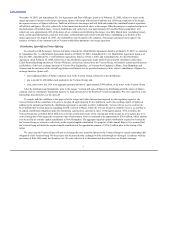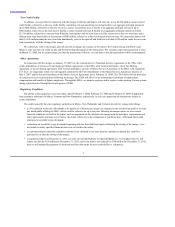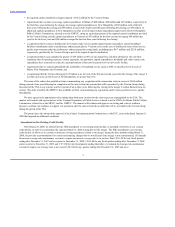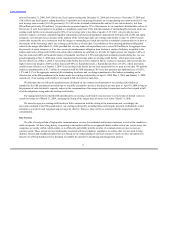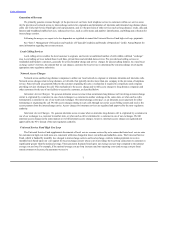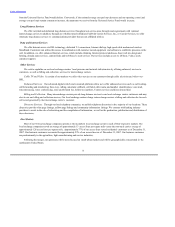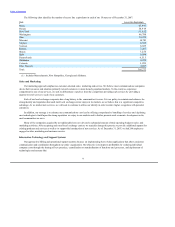FairPoint Communications 2007 Annual Report Download - page 15
Download and view the complete annual report
Please find page 15 of the 2007 FairPoint Communications annual report below. You can navigate through the pages in the report by either clicking on the pages listed below, or by using the keyword search tool below to find specific information within the annual report.
Table of Contents
comply with the 1996 Act, which amended the Communications Act by adding provisions intended to promote competition in the
provision of local service, and to lead to deregulation as markets become more competitive.
Our local exchange subsidiaries receive compensation from long-distance telecommunications providers for the use of their network
to originate and terminate interstate inter-exchange traffic. With respect to intrastate traffic, the FCC regulates the prices we may charge for
this purpose, referred to as access charges, as a combination of flat monthly charges paid by end-users and usage-sensitive charges paid
by long-distance carriers, and recurring monthly charges for use of dedicated facilities by long distance carriers. The amount of access
charge revenue that we will receive is subject to change.
Following the transactions, the non-rural operations will be subject to price cap regulation of access charges. Under price cap
regulation, limits are imposed on a company’s interstate rates without regard to its costs or revenue requirements. These limits are
adjusted annually based on FCC-specified formulae, such as for inflation, as well as through occasional regulatory proceedings, but will
generally give us flexibility to adjust our rates within these limits. In contrast, our existing rural operations will be subject to interstate rate
of return regulation, permitting us to set rates for those operations based upon our allowed costs and projected revenue requirement,
including an authorized rate of return of 11.25%. In an order dated January 25, 2008, the FCC granted our request for a waiver of the
“all or nothing” rule, which will allow us to continue to operate the non-rural and existing rural operations under these respective regimes
until the FCC completes its general review of whether to modify or eliminate the all or nothing rule.
The FCC has made various reforms to the existing rate structure for access charges, which, combined with the development of
competition, have generally caused the aggregate amount of access charges paid by long-distance carriers to decrease over time. Other
reform proposals are now pending. The FCC has not yet announced whether it will take any action with respect to its comprehensive
reform proposal for intercarrier compensation, which seeks, among other things, to unify state and interstate intercarrier charges in
certain circumstances, provide a mechanism to replace intercarrier revenues lost through rate unification, and resolve a number of
outstanding disputes among carriers regarding interconnection and compensation obligations. The FCC has also sought comment on
whether access charges should apply to VoIP or other Internet protocol-based service providers. We cannot predict what changes, if any,
the FCC may eventually adopt and the effect that any of these changes may have on our business.
Current FCC rules provide different methodologies for the determination of universal service payments to rural and non-rural
telephone companies. In general, the rules provide high-cost support to rural telephone companies where the company’s actual costs exceed
a nationwide benchmark level. High-cost support for non-rural telephone companies, on the other hand, is determined by nationwide
proxy cost model. Under the current FCC rules, following the transactions our non-rural operations will receive support under the non-
rural model methodology in Maine and Vermont. The FCC’s current rules for support to high-cost areas served by non-rural local
telephone companies were remanded by the U.S. Court of Appeals for the Tenth Circuit, which had found that the FCC had not
adequately justified these rules. The FCC has initiated a rulemaking proceeding in response to the court’s remand, but its rules remain in
effect pending the results of the rulemaking. The FCC is also considering proposals to update the proxy model upon which non-rural
high-cost funding is determined, as well as other possible reforms to the support mechanism for non-rural carriers.
The payments that are received by the existing rural operations from the Universal Service Fund will be intended to support the high
cost of our operations in rural markets. Under current FCC regulations, the total Universal Service Fund support available for high-cost
loops operated by rural local telephone companies is subject to a cap. The FCC prescribes the “national average cost per loop” each year to
keep the total available funding within the cap. Payments from the Universal Service Fund will fluctuate based upon our average cost per
loop compared with the national average cost per loop. For example, if the national average cost per loop
13


